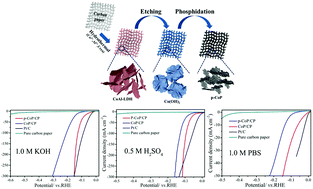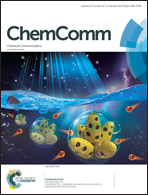Porous CoP nanosheets converted from layered double hydroxides with superior electrochemical activity for hydrogen evolution reactions at wide pH ranges†
Abstract
Porous materials are widely studied in many applications due to their high surface area and rich edge sites. Here, for the first time, we reported a simple and convenient method to synthesize porous nanosheets of metal hydroxides by selectively etching amphoteric Al in CoAl layered double hydroxides on carbon paper (CoAl-LDH/CP), and then convert them into porous cobalt phosphide nanosheets on carbon paper (p-CoP/CP) via low temperature phosphidation. In contrast to pristine cobalt phosphide nanosheets on carbon paper (CoP/CP), p-CoP/CP has lower overpotential, Tafel slope and charge transfer resistance as well as higher electrochemically active surface area. The excellent electrochemical characteristics make it have outstanding catalytic activity and stability over the whole pH range. In 1.0 M KOH, the p-CoP/CP only requires an overpotential of 57 mV to drive 10 mA cm−2. To achieve the same current density, it only needs overpotentials of 39 and 60 mV in 1.0 M H2SO4 and 1.0 M PBS, respectively. To our knowledge, it is the best among those nonprecious electrocatalysts used for hydrogen evolution in neutral solution. Moreover, this catalyst offers good durability over the whole pH range.



 Please wait while we load your content...
Please wait while we load your content...